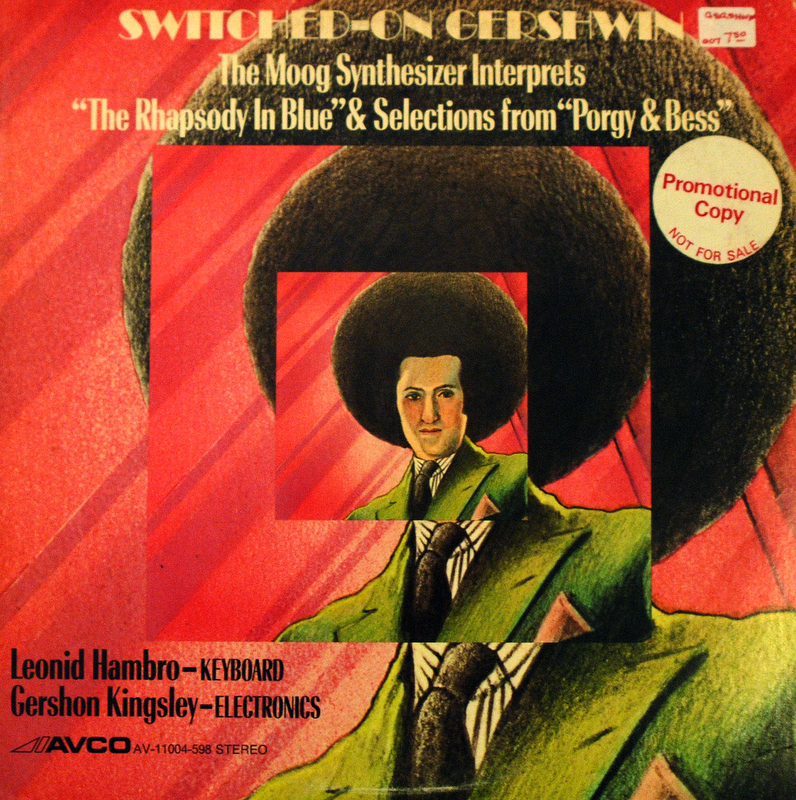Quick reminders/shameless plugs/pleas for cash!
I wrote this review of the Maniac vinyl by Death Waltz over at my other website! It’s really good! (The record, I mean…although yeah, my website is pretty rad too.)
I wrote this little piece about audio warnings you’d find on old CD-ROM games at my other website too! It’s really dumb (The article I mean…although, y’know.)
I’m selling a bunch of stuff on eBay, if you like Criterion discs and really really low price (and I mean LOW) check them out!
Finally, I’m still trying a sell a TON of records, while I’ve been adding a few to eBay every now and then, I’d still prefer to sell them direct via my website. So if you’re interested, head on over to this post to find out more about that.
Now for Moog covers of Gershwin songs.
Gershon Kinglsey – Switched-On Gershwin
Rhapsody In Blue
I Got Rhythm
Porgy and Bess Introduction And Opening Scene I
Summertime
My Man’s Gone Now
It Ain’t Necessarily So
Clara, Clara
Crown’s Killing
In America, three people are widely credited with bringing early electronic music into the pop realm; Wendy Carlos, Dick Hyman (hehe) and Gershon Kingsley.
Wendy Carlos took electronic music and made it mainstream with Switched-On Bach, creating the first best-selling and Grammy award-winning electronic album, while Dick Hyman, who was already an accomplish jazz musician, took electronic music and made it respectable with his all-Moog albums full of original material.
However, sometimes I think that Kingsley gets lost in the shuffle, as he (along with with collaborator Jean-Jacques Perrey) were experimenting with the Moog and creating electronic pop music years before either Hyman or Carlos.
Carlos’ Switched-On Bach came out in 1968. Hyman’s first all-Moog album debuted in 1969. Perrey And Kinglsey’s debut album, The In Sound From Way Out, came out in 1966. The same year that The Beatles released Revolver, the same year that Tom Jones won the Best New Artist Grammy (really), these two crazy bastards were experimenting with previously unheard of electronic instruments, literally creating a sound that no one had ever heard before.
And they were doing it with mostly original tunes, not covers or interpretations of classical material. They were breaking ground in every way imaginable. It’s really amazing when you think about it. Of course, the true innovators never get the credit they deserve, and it was Wendy Carlos who broke electronic music through to the mainstream with Switched-On Bach. It makes sense though, better to expose modern audiences to electronic music via a sound they know than one they don’t. And Switched-On Bach is an amazing record, one that still sounds awesome and futuristic to this day.
It also inspired a legion of rip-off “Switched-On” albums. For some reason, in the coming years the term “Switched-On” came to mean “electronic music” and artists were releasing “Switched-On” country music, Beatles covers, showtunes, you name it, it got a “Switched-On” treatment.
It was such a popular trend that even innovators like Kingsley cashed in on it with Switched-On Gershwin, which as you can probably guess from the title, offers a selection of George Gershwin pieces redone as Moog tracks.
However, this “Switched On” albums differs from many imitators in a few ways.
Firstly, it wasn’t always a “Switched On” release. The record was first released in 1970 under the name Gershwin: Alive & Well & Underground, and may have come out so close to the original release of Switched-On Bach that it’s probably not fair to call the album a cash-in on that other record’s success. Kingsley’s decision to cover Gerswhin tunes was most likely independent of the success of Carlos’ LP.
Secondly, it’s not an entirely all-Moog album. The showcase track of the record, the 14-minute take on Gershwin’s classic “Rhapsody In Blue,” employs ample piano performed by Leonid Hambro. It may seem like a minor thing to mention, but the track’s constant interplay between the traditional piano and the more experimental, modern Moog effects really makes it stand out in a way that other Moog albums can’t lay a claim to. It also wonderfully showcases the playful and upbeat feeling of the original piece.
Finally, and most importantly, while most “Switched-On” records were bland and unoriginal albums created by people without a creative bone in their body, Switched-On Gershwin is fucking amazing.
Kingsley may be performing someone else’s music here, but he interjects as much originality and creativity within the confines of those songs as humanely possible. These tracks are layered with all kinds of sound effects and really showcase the power of the Moog far more than Carlos’ album did. It’s obvious listening to this record that Kingsley probably knew more about the Moog and what it was capable of than nearly anyone else who was using it at the time, radically altering these tracks and making them his own. Listen to his version of “I Got Rhythm” or “Porgy And Bess Introduction And Opening Scene I” and tell me they’re mere covers. You can’t. He transforms them into something entirely unique and beautiful. It’s really incredible.
And that cover is fucking DOPE.


$28.25 to ship a single DVD to Canada? Holy shit man…!
Sorry! I changed the shipping options, give it a go now.